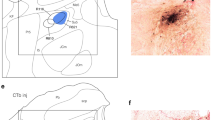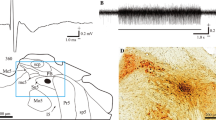Abstract
Previous studies performed in rats showed that the whisker-pad motor innervation involves not only the facial nerve, but also some hypoglossal neurons whose axons travel within the trigeminal infraorbital nerve (ION) and target the extrinsic muscles surrounding the whisker-pad macrovibrissae. Furthermore, the electrical stimulation of the ION induced an increase in the EMG activity of these muscles, while the hypoglossal nucleus stimulation elicited evoked potentials and single motor unit responses. However, the existence of a neural network able to involve the XIIth nucleus in macrovibrissae whisking control was totally unknown until now. Since other recent experiments demonstrated that: (1) the mesencephalic trigeminal nucleus (Me5) neurons respond to both spontaneous and artificial movements of macrovibrissae, and (2) the Me5 peripheral terminals provide a monosynaptic sensory innervation to the macrovibrissae, the present study was aimed at analyzing a possible role of the Me5 nucleus as a relay station in the sensory-motor loop that involves the XIIth nucleus neurons in rhythmic whisking control. Two tracers were used in the same animal: Fluoro Gold, which was injected into the whisker pad to retrogradely label the hypoglossal whisker-pad projection neurons, and Dil, which was instead injected into the Me5 to label its projections to these hypoglossal neurons. Results demonstrated that terminals of the Me5 neurons monosynaptically target the hypoglossal whisker-pad projection neurons. The functional role of this sensory-motor connection is discussed, with particular regard to a hypothesized proprioceptive reflex in whisker-pad extrinsic muscles that can be elicited by the activation of the Me5 macrovibrissae receptors.



Similar content being viewed by others
References
Aldes LD (1980) Afferent projections to the hypoglossal nuclei in the rat and cat. Anat Rec 196:7A
Appenteng K, Morimoto T, Taylor A (1980) Fusimotor activity in masseter nerve of the cat during reflex jaw movements. J Physiol (Lond) 305:415–431
Appenteng K, Donga R, Williams RG (1985) Morphological and electrophysiological determination of the projection of jaw elevator muscle spindle afferents in rats. J Physiol (Lond) 369:93–113
Berg RW, Kleinfeld D (2003) Rhythmic whisking by rat: retraction as well pronation of the vibrissae is under active muscular control. J Neurophysiol 89:104–117
Berthoud HR, Kressel M, Neuhuber WL (1992) An anterograde tracing study of the vagal innervation of rat liver, portal vein and biliary system. Anat Embryol 186:431–442
Borke R, Nau ME (1987) The ultrastructural morphology and distribution of trigemino-hypoglossal connections labeled with horseradish peroxidase. Brain Res 442:235–241
Borke R, Nau ME, Ringler RL Jr (1983) Brain stem afferents of hypoglossal neurons in the rat. Brain Res 269:47–55
Bowden RE, Mahran ZY (1956) The functional significance of the pattern of innervation of the muscle quadratus labii superioris of the rabbit, cat and rat. J Anat 90:217–227
Brodal A (1981) Neurological anatomy in relation to clinical medicine. Oxford University Press, New York
Dőrfl J (1982) The musculature of the mystacial vibrissae of the white mouse. J Anat 135:147–154
Dőrfl J (1985) The innervation of the mystacial region of the white mouse. A topographical study. J Anat 142:173–184
Ebara S, Kumamoto K, Matsuura T, Mazurkiewicz JE, Rice FL (2002) Similarities and differences in the innervation of mystacial vibrissal follicle-sinus complexes in the rat and cat: a confocal study. J Comp Neurol 449:103–119
Grant G (2006) The 1932 and 1944 Nobel Prizes in physiology or medicine: rewards for ground-breaking studies in neurophysiology. J Hist Neurosci 15(4):341–357
Haidarliu S, Simony E, Golomb D, Ahissar E (2010) Muscle architecture in the mystacial pad of the rat. Anat Rec (Hoboken) 293:1192–1206
Henstrom D, Hadlock T, Lindsay R, Knox CJ, Malo J, Vakharia KT, Heaton JT (2012) The convergence of facial nerve branches providing whisker pad motor supply in rats: implications for facial reanimation study. Muscle Nerve 45:692–697
Hill DN, Bermejo R, Zeigler HP, Kleinfeld D (2008) Biomechanics of the vibrissa motor plant in rat: rhythmic whisking consists of triphasic neuromuscular activity. J Neurosci 28:3438–3455
Honig MG, Hume RI (1989) Dil and DiO: versatile fluorescent dyes for neuronal labeling and pathway tracing. Trends Neurosci 12:333–341
Jerge CR (1963) Organization and function of the trigeminal mesencephalic nucleus. J Neurophysiol 26:379–392
Jin TE, Witzemann V, Brecht M (2004) Fiber types of the intrinsic whisker muscle and whisking behavior. J Neurosci 24:3386–3393
Kleinfeld D, Berg RW, O’Connor SM (1999) Anatomical loops and their electrical dynamics in relation to whisking by rat. Somatosens Motor Res 16:69–88
Linden RWA, Scott BJJ (1989) Distribution of mesencephalic nucleus and trigeminal ganglion mechanoreceptors in the periodontal ligament of the cat. J Physiol 410:35–44
Linden RWA, Millar BJ, Halata Z (1994) A comparative physiological and morphological study of periodontal ligament mechanoreceptors represented in the trigeminal ganglion and the mesencephalic nucleus of the cat. Anat Embryol 190:127–135
Lingenhőhl K, Friauf E (1991) Sensory neurons and motoneurons of the jaw-closing reflex pathways in rats: a combined morphological and physiological study using the intracellular horseradish peroxidase technique. Exp Brain Res 83:385–396
Lund JP, Lamarre Y, Lavigne G, Duquet G (1983) Human jaw reflexes. Adv Neurol 39:739–755
Luo PF, Wang BR, Peng ZZ, Li JS (1991) Morphological characteristics and terminating patterns of masseteric neurons of the mesencephalic trigeminal nucleus of the rat: an intracellular horseradish peroxidase labeling study. J Comp Neurol 303:289–299
Luo P, Moritani M, Dessem D (2001) Jaw-muscle spindle afferent pathways to the trigeminal motor nucleus in the rat. J Comp Neurol 435(3):341–353
Mameli O, Pellitteri R, Russo A, Stanzani S, Caria MA, De Riu PL (2006) Role of trigeminal nerve in regrowth of hypoglossal motoneurons after hypoglossal-facial anastomosis. Acta Oto-Laryngol 126:1334–1338
Mameli O, Stanzani S, Russo A, Romeo R, Pellitteri R, Spatuzza M, Caria MA, De Riu PL (2008) Hypoglossal nuclei participation in rat mystacial pad control. Pfüger Arch—Europ. J Physiol 456:1189–1198
Mameli O, Stanzani S, Russo A, Pellitteri R, Spatuzza M, Caria MA, Mulliri G, De Riu PL (2009) Hypoglossal nucleus projections to the rat masseter muscle. Brain Res 1283:34–40
Mameli O, Stanzani S, Mulliri G, Pellitteri R, Caria MA, Russo A, De Riu PL (2010) Role of the trigeminal mesencephalic nucleus in rat whisker pad proprioception. Behav Brain Funct 6:69–80
Mameli O, Stanzani S, Russo A, Pellitteri R, Manca P, De Riu PL, Caria MA (2014) Involvement of trigeminal mesencephalic nucleus in kinetic encoding of whisker movements. Brain Res Bull 102:37–45
Matesz C (1981) Peripheral and central distribution of fibres of the mesencephalic trigeminal root in the rat. Neurosci Lett 27:13–17
Mizuno N, Sauerland EK (1970) Trigeminal proprioceptive projections to the hypoglossal nucleus and cervical grey column. J Comp Neurol 139:215–226
Paxinos G, Watson C (1997) The rat brain in stereotaxic coordinates. Academic Press, Sydney
Raappana P, Arvidsson J (1993) Location, morphology, and central projections of mesencephalic trigeminal neurons innervating rat masticatory muscles studied by axonal transport of choleragenoid-horseradish peroxidase. J Comp Neurol 328(1):103–114
Rice FL, Mance A, Munger B (1986) A comparative light microscopic analysis of the sensory innervation of the mystacial pad. I. Innervation of the vibrissal follicle-sinus complexes. J Comp Neurol 252:154–174
Semba K, Egger MD (1986) The facial “motor” nerve of the rat control of vibrissal movement and examination of motor and sensory components. J Comp Neurol 247:144–158
Shigenaga Y, Doe K, Suemune S, Mitsuhiro Y, Tsuru K, Otani K, Shirana Y, Hosoi M, Yoshida A, Kagawa K (1989) Physiological and morphological characteristics of periodontal mesencephalic trigeminal neurons in the cat intra-axonal staining with HRP. Brain Res 505:91–110
Simony E, Bagdasarian K, Herfst L, Brecht M, Ahissar E, Golomb D (2010) Temporal and spatial characteristics of vibrissa responses to motor commands. J Neurosci 30:8935–8952
Szentàgothai J (1948) Anatomical considerations of monosynaptic reflex arcs. J Neurophysiol 11:454–455
Tamamaki N (1997) Organization of entorhinal projections to the rat dentate gyrus revealed by Dil anterograde labeling. Exp Brain Res 116:250–258
Taylor A, Durbaba R, Rodgers JF (1992) The classification of afferents from spindles of the jaw-closing muscles of the cat. J Physiol (Lond) 456:609–628
Travers JB (1995) Oromotor nuclei. In: Paxinos G (ed) The rat nervous system. Academic Press, New York, pp 239–255
Travers JB, Norgren R (1983) Afferent projections to the oral motor nuclei in the rat. J Comp Neurol 220:280–298
Wineski LE (1983) Movements of the cranial vibrissae in the Golden Hamster (Mesocricetus auratus). J Zool (Lond) 200:261–280
Woodhams PL, Terashima T (2000) Aberrant trajectory of entorhino-dentate axons in the mutant Shaking Rat Kawasaki: a Dil-labeling study. Eur J Neurosci 12:2707–2720
Zhang J, Luo P, Pendlebury WW (2001) Light and electron microscopic observations of a direct projection from mesencephalic trigeminal nucleus neurons to hypoglossal motoneurons in the rat. Brain Res 917:67–80
Zhang J, Pendlebury WW, Luo P (2003) Synaptic organization of monosynaptic connections from mesencephalic trigeminal nucleus neurons to hypoglossal motoneurons in the rat. Synapse 49(3):157–169
Author information
Authors and Affiliations
Corresponding author
Rights and permissions
About this article
Cite this article
Mameli, O., Caria, M.A., Pellitteri, R. et al. Evidence for a trigeminal mesencephalic-hypoglossal nuclei loop involved in controlling vibrissae movements in the rat. Exp Brain Res 234, 753–761 (2016). https://doi.org/10.1007/s00221-015-4503-6
Received:
Accepted:
Published:
Issue Date:
DOI: https://doi.org/10.1007/s00221-015-4503-6




